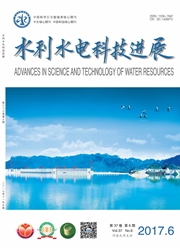

 中文摘要:
中文摘要:
通过对三峡库区中部典型支流梅溪河库湾水动力参数及水体温度、浊度数据进行分析,研究水库运行各时期梅溪河河口干支流界面水流特性,探讨其影响因素以及水交换对库湾的影响。结果表明:梅溪河河口双向水流特征明显,在温差异重流、干流惯性作用以及库区水位变动等因素影响下,干支流界面水流强度、进出水体间界面结构及形态在不同运行期有显著差异;由于双向水流结构的存在,尽管梅溪河河口干支流界面净流量较小(多小于100 m^3/s),但是干支流水体的交换量相对显著,介于314.17-535.26 m^3/s之间,可达净流量的4-40倍;在净流量最小的低水位运行期,干流倒灌水体基本能到达支流库湾常年回水区的末端。
 英文摘要:
英文摘要:
Based on analyses of the hydrodynamic parameters,turbidity,and temperature of water in the bay of the Meixi River,a typical tributary in the middle area of the Three Gorges Reservoir area,the characteristics of flow at the interface between the mainstream and the tributary during different operation stages of the Three Gorges Reservoir were investigated, and the factors influencing the flow characteristics and the influence of water exchange on the bay are discussed. The results show that the flow is bidirectional in the Meixi Estuary. Driven by the thermal density flow, the inertia of mainstream flow, and changes in the reservoir water level, the flow intensity at the interface and the structure and pattern of the interface between the inflow and outflow differed in different operation stages. The net flux is low (mostly below 100 m^3/s),while the water exchange volume (from 314. 17 to 535. 26 m^3/s , about 4 to 40 times the net flux) is relatively large at the interface in the Meixi River Estuary because of the bidirectional flow. The mainstream inflow could reach the end of the perennial backwater zone even during the low-water level stage with minimum net flux.
 同期刊论文项目
同期刊论文项目
 同项目期刊论文
同项目期刊论文
 期刊信息
期刊信息
